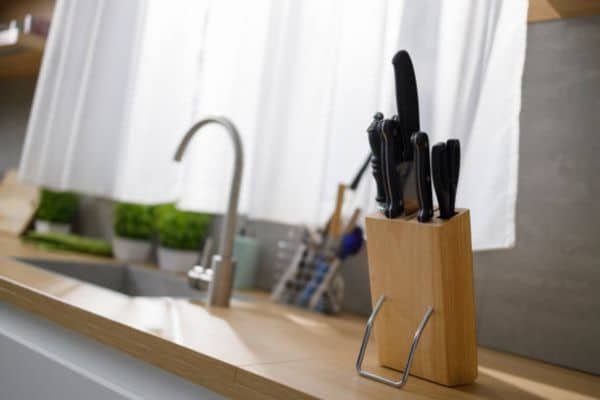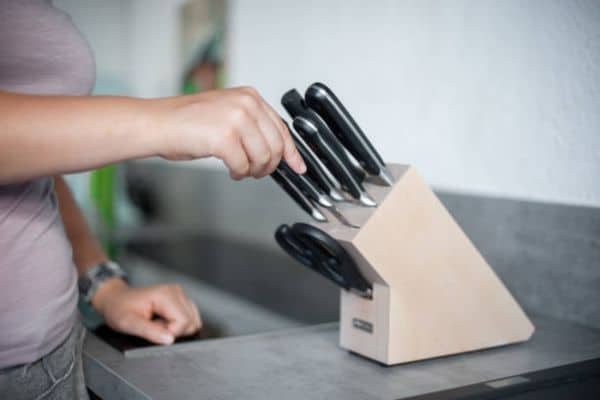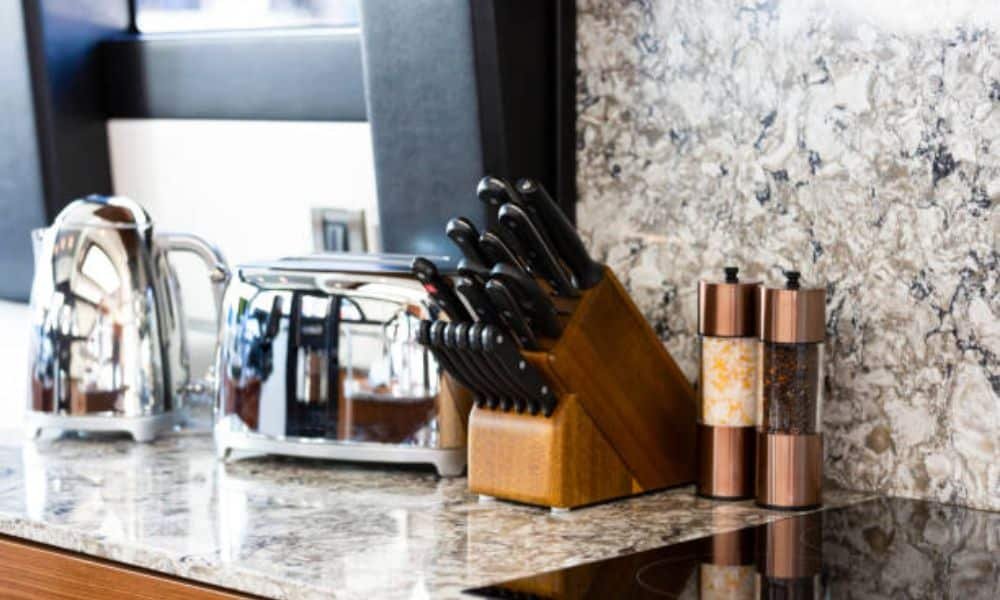Picture a calm Sunday brunch. I slide toast onto the plate. The knife block skids, tips, then clatters. My heart jumps as steel flashes. That slip taught me a clear lesson. A loose block turns prep into risk. Counters get dents. Fingers face worse. I have cooked each day for twenty years. I test gear for food mags. Spills and fixes fill my journal. In the next lines you will master How To Secure A Knife Block On Countertop. The plan uses pads, gel, and a quick wipe. No heavy tools. No stress.
Why a Secure Knife Block Matters
A loose knife block spells trouble. One sudden skid can launch sharp steel toward hands, toes, or a polished counter. Safety starts with still blades.
Secure storage stops cuts and chips before they start. How To Secure keeps prep calm, clean, and quick. Small pads or gel give instant grip, turning chaos into control.
Steady blocks guard your tools, too. Firm footing stops edge wear, cracks, and dull tips. Knives stay sharp, blocks stay whole, and counters stay spotless.
Even the best kitchen knife set under 100 deserves that care. A snug block treats budget blades like luxury gear, letting them slice smooth for years.
How To Secure A Knife Block On Countertop: Step-by-Step

A steady starts with simple fixes. No drills, no stress—just a few easy steps and some kitchen common sense. Here’s how to do it right.
Tools You May Need:
- Soft cloth
- Mild cleaner or rubbing alcohol
- Rubber or silicone non-slip pads
- Museum gel or putty
- Silicone mat or drawer liner
- Velcro or adhesive strips
01. Choose the Right Spot

Pick a flat, level part of your counter. Corners or spots near the wall work best. Avoid areas near water or stove heat. You want a spot where the block won’t be bumped often.
02. Clean the Surface
Wipe the counter where the block will sit. Use mild soap or rubbing alcohol. Dry it well. This helps everything stick better and keeps dust from ruining the grip.
03. Add Non-Slip Pads
Stick rubber or silicone pads to the base. Place one in each corner. Press down hard to secure them. These pads give instant grip and stop sliding.
04. Apply Museum Gel or Putty
Take a small bit of museum gel. Roll it into little balls. Stick them under the block—one on each corner. Press down on the counter. It’ll grip tight but can still be moved later without damage.
05. Try a Silicone Mat or Drawer Liner
Place a silicone mat under the knife block. It adds friction and cushions the base. This is a good choice for marble or slick counters. Cut to size for a neat look.
06. Use Velcro or Adhesive Strips for Extra Hold
Need something stronger? Stick Velcro or double-sided strips to the bottom of the block. Then press it to the counter. This gives a semi-permanent grip, perfect for high-traffic kitchens.
Tips from a Seasoned Home Cook

A knife block may look solid, but it needs a little care. Over time, even a steady block can shift. A weekly check with your hand keeps things safe. Just press gently and see if it slides.
Keep the counter dry. Water makes blocks slip. It also wears out pads and gels. A quick wipe with a towel after cooking helps a lot.
Don’t pack the block too full. Think of it like a closet—stuffed too tight, things fall out. Give each knife space to rest. They’ll stay sharp and be easier to grab.
Felt pads are great. They grip well and stop small scratches on stone counters. They also keep quiet when you move it.
My favourite trick? A bit of museum gel in each knife slot. It cushions the blade and softens sound. Like soft-close drawers, but for your knives.
Bonus: Safe Storage for Budget-Friendly Knife Sets
Even a low-cost knife can feel high-end with the right care. A solid block gives your tools a steady home. No clatter. No chips. Just smooth, safe storage.
The best kitchen knife set under 100 still needs love. These sets often come with lightweight blocks. That means a greater chance of slipping. Add non-slip pads or a silicone mat. It makes a big difference for just a few bucks.
Want your blades to last? Keep them dry and snug. Wipe each one before it goes back. Don’t jam them into tight slots. A little space helps the edge stay sharp.
A steady block means safer cuts. Your hand moves with confidence. The knife stays balanced. Over time, this also keeps handles tight and blades free from nicks.
Common Mistakes to Avoid

Some mistakes look small but cause big problems over time. A few smart changes can save your knives and keep your kitchen safe.
Never place near heat or water. Heat dries out wood. Water makes it swell or slip. Keep the block away from sinks and stoves. Choose a cool, dry spot instead.
Avoid overloading the block. Too many knives make it top-heavy. It also puts stress on the slots. Your tools deserve room to breathe. Less is more here.
Don’t ignore small wobbles. A slight shift today can lead to a fall tomorrow. Check the base now and then. A quick fix keeps accidents away.
Conclusion
A safe kitchen starts with small steps. We picked the right spot, cleaned the surface, and added simple fixes like pads, gel, or mats. Each tip helps keep steady and your hands safe.
Securing isn’t just about looks—it protects your tools, your counter, and most of all, you. So take a few minutes today. Give your knives the safe home they deserve. It’s quick, easy, and worth it.
FAQs
Can I use a non-slip mat under my knife block?
Yes, a non-slip mat works great. It keeps the block steady and protects your countertop. Just cut it to size and place it under for a firm grip.
What’s the safest place to put a knife block?
The safest spot is on a flat, dry counter away from heat or water. Corners or against a wall are best. These spots stop slips and keep knives out of the way.
Is it safe to store knives in drawers?
Yes, but use an in-drawer or blade cover. Loose knives in drawers can dull fast and cause cuts. A proper holder keeps blades safe and easy to grab.

